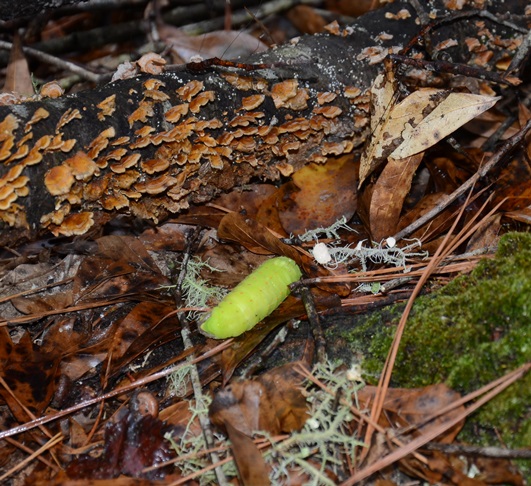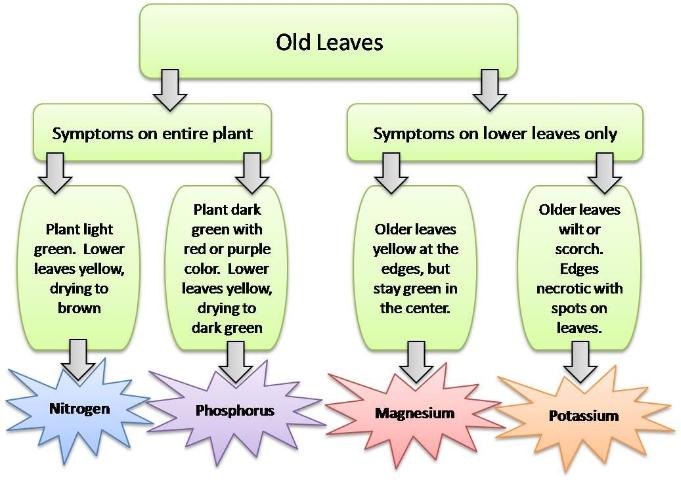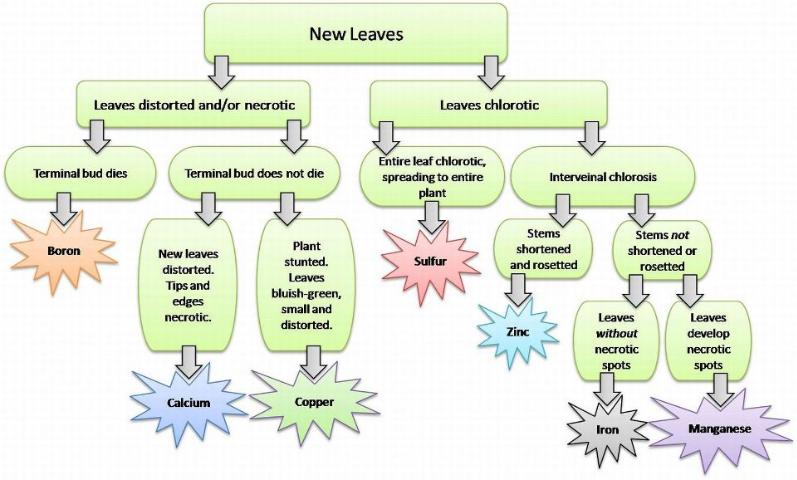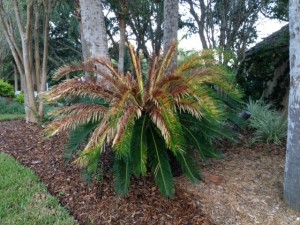
by Les Harrison | Jan 22, 2015

Fallen leaves add much to the landscape. They feed the plants and many insect, retain water, and help stabilize the soil
For the homeowner who feels the need to rake leaves and pine needles, the task can be something of a minor nuisance. The showers of earth-toned leftovers appear suddenly and at inconvenient times, and their removal is never added to a chore list without dispute.
Disarray aside, these organic remnants provide far more benefits than problems. Their suburban untidiness becomes an insulating blanket which nurtures plants, animals, and insects with time released nutrients for use by the efficient and fortunate in the wild and those of us in civilization.
First and foremost, leaf litter is critical to the water holding capacity of the woodlands. The dried leaves, needles and twigs absorb and shade rainwater from the evaporative effects of the sun and wind.
When heavy rains inundate the soil causing flooding and runoff, it is the leaves that act as part of the natural delaying system to minimize the negative impact on streams, creeks and rivers. The delayed or halted runoff provides time for water to be absorbed by the soil and be filtered by the natural screening capacity of this organic material.
The moisture works in conjunction with native bacteria and fungus to convert the leaf litter into nutrients usable by plants and trees. While not as concentrated as commercial fertilizers, many of the same plant nutrients are present in the decaying leaf litter.
The decomposition is aided by a variety of insects and worms which nest in, eat and overwinter under the debris. The animal activity breaks up and stirs the elements along with inoculating microbes in the matter which speeds nutrient availability to plants and trees during ideal years.
Luckily, the region’s leaf drop is spread over months with the plants and trees responding to the solar cycle and weather. Autumn, winter and spring each bring defoliation of specific trees and plants.
During dry years the bug and bacteria activity slows in accumulated leaf litter, but the naturally occurring fire cycle continues the nutrient recycling under the tree canopies. The easy to burn material aides in controlling insects and plants that can aggressively overpopulate an area if unchecked.
Controlled burns also prevent destructive wildfires which are harmful to all north Florida residents. While these uncontrolled fires do deposit nutrients, they have many negative effects which far outweigh this single benefit.
January’s weather is part of a continuing natural succession which the native plants and trees incorporate to continue the wild beauty so common in the region. The current cold and rain will combine with the leaf drop to produce much growth in the next few months.
by Julie McConnell | May 3, 2014
The last week of April 2014 brought with it 10-22 inches of rain across the panhandle in a matter of days. Some areas had immediate flooding and standing water, while others may be in areas at risk of rising rivers and streams. As the water recedes, many people are wondering how all the water will affect their landscapes.
Only time will tell what the long term impact will be, but here are a few things to watch for and what you can do to try to moderate damage.
- Let soils dry out before driving vehicles or other equipment on grassy areas. Even if the water is not visible, if the soil is still saturated, driving lawn equipment or cars may cause ruts.
- Do not leave automatic irrigation systems running on established shrubs, trees, and lawns. If your system is set to run in the early morning hours, you may not think about it being on, check your systems and hold off on adding water until soils dry out and the plants need it.
- Watch for fungus symptoms and treat if needed. Wet plants and cool weather are ideal for some Brown Patch on lawns, be aware and monitor landscapes closely. If disease is suspected, contact your local county extension office for recommendation.
- When mowing, leave a longer leaf blade to compensate for root stress.
- Look at the base of trees and shrubs to make sure silt and sand have not buried the crown or root flare. Also look for erosion of root zone, these areas may need correction. “Salvaging Flood-Damaged Shrubs and Ornamentals.”
- Adjust fertilization as needed; if you recently applied fertilizer it has likely runoff or leached from the site. However, if you suspect fungal disease do not fertilize until disease is managed.
- Stress in turfgrass, for details read “Watch Turf for Flooding Stress”
- You may see new weeds (seeds or segments may have washed or blown into your yard)
- Tree and shrub decline or death read “We Had Plenty of Rain, Why are My Trees Dying?”
- Although this storm was not a hurricane, “Assessing Damage and Restoring Trees After a Hurricane” has helpful information for areas with wind damage
- Nutritional deficiency symptoms in palms may show up 4-5 months from now. “Nutrient Deficiencies of Landscape and Field-grown Palms in Florida.”
- Decreased availability and increased price of sod (flooded fields prevent harvest and increase inputs for disease, weed, and nutrition management)
- Scheduling changes or maintenance adjustments by landscape contractors. Turfgrass and ornamentals will likely need different maintenance applications than in years past to correct issues related to flooding and excess rain.
by Taylor Vandiver | Apr 29, 2014
Now that spring has finally sprung and summer is well on its way, you may find yourself taking a stroll through your landscape and assessing damage done by late cold spells. However, it may not be a frost problem that has your plants looking worse for the wear. They could be experiencing nutritional imbalances which affect overall plant health. Most cases involving nutrition issues in plants can be linked back to the soil. Therefore, if you suspect a problem I suggest testing your soil to ascertain pH and nutrient levels. You can obtain a soil test kit at your local UF IFAS Extension office. Another way to diagnose your plant damage is to visually catalog its symptoms. Symptoms of mobile nutrients, such as nitrogen and phosphorus, tend to reveal themselves on older leaves first. Whereas, immobile nutrient symptoms (i.e. boron and calcium) will show up on newer leaves. These flow charts can help to narrow down which essential element may be lacking in your plant’s diet.

Mobile Nutrient Symptoms.

Immobile Nutrient Symptoms.
by Mary Salinas | Sep 23, 2013
Is the newest growth on your sago palm turning yellow, brown, frizzy looking and dying – is it a pest or disease or something else?

Photo credit: Mary Derrick
This sago palm is suffering from a classic case of manganese deficiency. When sago palms lack manganese, the newest leaves will develop yellow splotches or be entirely yellow. As the leaves die, they turn brown and take on a frizzled appearance. Sometimes the leaves or fruit may be smaller than normal. If left unchecked, the sago usually dies.
Manganese is a micronutrient required by all plants for normal, healthy growth and is most available for plant uptake when the soil pH is between 5.5 and 6.5. Soils in the Florida panhandle are often naturally low in manganese and then what available manganese is present can be unavailable for the plant to use if the pH of the soil is much above 6.5. Also, manganese tends to be leached from the soil when the pH is below 5.5. Soil pH and nutrient testing is useful to determine if soils are nutrient deficient. Contact your county Extension office for information on getting that done.
[notice]Before treating, rule out an infestation of Asian cycad scale. Click here for a UF IFAS Extension publication on this damaging insect. Be aware that both are common problems for sago palms and that your sago may be afflicted with both![/notice]
If this is happening to a sago palm, the good news is that it is easy to correct. Manganese sulfate is readily available at garden centers, feed &seed stores and independent nurseries. Just make sure to get manganese sulfate and don’t confuse it with magnesium sulfate (Epson salts). The amount of manganese sulfate necessary to correct this deficiency will vary with its size, soil type and pH. Sago palms in sandy, acidic soils require less manganese sulfate than those in high pH soils. One ounce is sufficient for a very small plant in sandy, acidic soil. A very large sago in a high pH soil may require about five pounds, however. Spread the product evenly over the root zone and water in with about a half inch of water.
The affected leaves cannot be cured but new growth should return to normal. If the new growth is still affected, an additional application of manganese sulfate may be needed. Once sago palms have suffered from a manganese deficiency, half the initial rate should be applied yearly to prevent the deficiency from re-occurring.
Even though sago palms are not true palms – they are cycads – their nutritional needs are very similar to palms. Most of the time they grow well without any supplemental fertilization, but if they do need fertilizing, use a 8-2-12-4 (the fourth number is magnesium) palm fertilizer with micronutrients and avoid using other fertilizer products in their root zones.
For more information on sago palms please see:
Cycas revoluta, Sago Palm





